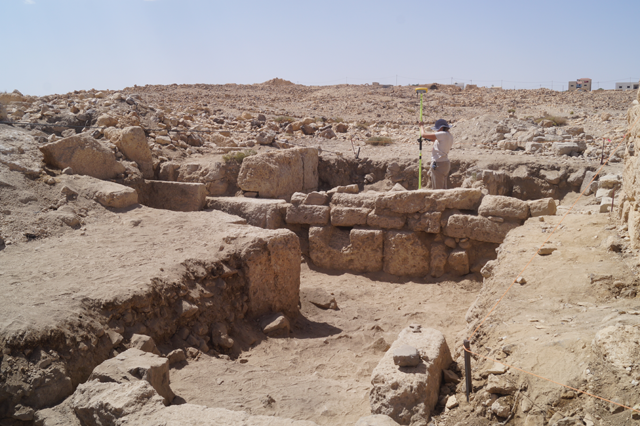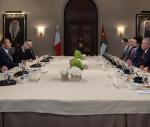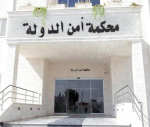You are here
Dutch scholar seeks to unravel ‘almost forgotten’ site of Udhruh
By Saeb Rawashdeh - Feb 11,2018 - Last updated at Feb 11,2018
AMMAN — With the aim of exploring Roman military posts, the Udhruh Archaeological Project was initiated by the Petra College for Tourism and Archaeology (PCTA) of Al Hussein Bin Talal University in Wadi Musa, and three seasons of excavations were conducted in 2008, 2009 and 2011 by the PCTA, according to a Dutch scholar.
In the meantime, Dutch researchers became interested in the project when Dean of PCAT Fawzi Abudanah gave a presentation at a conference in Amsterdam in 2008, so PCAT and the Faculty of Archaeology of Leiden University teamed up, said Mark Driessen from Leiden University, who is co-director of the project with Abudanah..
“I knew Fawzi Abudanah from several international congresses, and during one of those events we talked about a possibility of a joint venture project related to Udhruh and its Roman legionary fortress,” said Driessen.
They discussed the possibilities with colleagues (former deans of the PCTA and Faculty of Archaeology from Leiden University Saad Twaissi and Willem Willems) and other stakeholders (former director general of the Department of Antiquities of Jordan Ziad Al Saad), Driessen noted.
The village of Udhruh, east of Petra, was an almost forgotten archaeological site until Abudanah drew attention to it again with his large scale surveys in the early 2000s, the Dutch archaeologist continued, adding that “earlier explorations — already form the 19th century — and excavations in the 80s revealed that Udhruh housed an important Nabataean settlement and a Roman legionary fortress”.
Moreover, the current village of Udhruh is dominated by and centred around the still standing remains of this fort, which was transformed into a town in post-Roman times, Driessen said, noting that classical literary and archaeological sources point to a long-term development from Nabataean till Islamic times.
“The surrounding landscape of Udhruh, with a diversity of surviving archaeological remains, can provide pivotal information to unravel the complex cultural, socioeconomic and religious transformation processes of the region,” he emphasised, adding that the archaeological variety and perfect preservation of this region were, in combination with the intriguing site itself, “essential criteria for starting a joint archaeological project between Leiden University and Al Hussein Bin Talal University in 2011”.
The Udhruh Archaeological Project started with a field-survey programme, small-scale excavations, diverse GIS-related and subsurface-detection techniques, underlined Driessen, who received his PhD from the University of Amsterdam.
“This was carried out with the aim to map and interpret the still visible and standing archaeological remains and to reconstruct the geomorphology of a 48sq.kilometres landscape in the Udhruh region,” he explained.
"Five years of field work revealed an actively exploited region with impressive and ingenious antique investments in agro-hydrological intensification, building material procurement, communication and security networks, military dominion and settlement development,” he added.
Especially the first: The methods of agriculture and the different means of water management employed in antiquity are "thrilling" and show that the people who lived here could have turned the steppe under semi-arid conditions — comparable with the current time — into a "green oasis", Driessen elaborated.
In 2016 and 2017, scholars started making 3D-models of the remains of the Roman fort and Byzantine-Islamic town of Udhruh by means of photogrammetry and 3D-scanning with a Leica P30 Laser scan, he said.
“With this we want to make 3D-models, which we can use for academic purposes, and which we would eventually like to convert into apps for smartphones and tablets whereby future tourists can experience the grandeur of these antique settlements standing on-site [or off-site] with their tablets/phones,” Driessen said, adding that the local community can hopefully benefit from this.
“We also started an oral history project together with our archaeological research as oral history provides information which is complementary to information obtained through archaeological research,” the archaeologist explained.
It also gives information about historical events, stories and myths related to the local communities, and this heritage has been passed orally from generation to generation, he highlighted, stressing the negative impact of urban migration and modernisation on oral legacies which fall “into oblivion”.
“We would like eventually — if we have the required funds for this — to publish collected narratives by a local printing company in both Arabic as in English,” Driessen said, adding that the future booklet would be distributed as a present to all local families and/or households as well as professionals and visitors.
“What the preliminary results up till now can show us is that the people in antiquity were employing a very sustainable approach to water management. I think that in close cooperation with different stakeholders and in an interdisciplinary research, we might be able to unravel these systems,” the scholar said.
“And I think these might give us insights for future solutions for agriculture and water, as we all know not only Jordan has problems with droughts, and access to fresh water is one of the greatest global challenges of the 21st century," Driessen concluded.
Related Articles
AMMAN — Professor Fawzi Abudanah from Al Hussein Bin Talal University in Maan conducted survey at Udhruh, a site located some 15 kilometres
MAAN — Udhruh is a site located some 15 kilometres east of Petra and represents an open laboratory in water management.
AMMAN – The area around the Nabataean and later Roman site Udhruh is covered with a network of smaller sites and watchtowers.


















